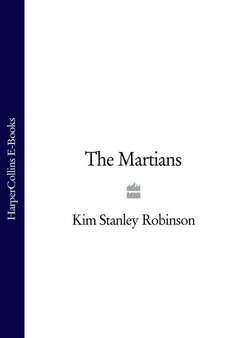Читать книгу The Martians - Kim Stanley Robinson - Страница 7
THREE THE ARCHAEA PLOT
ОглавлениеTHE LITTLE RED PEOPLE did not like terraforming. As far as they were concerned it wrecked everything, the way global warming wrecked things on Earth, only two magnitudes worse, as usual. Everything on Mars is two magnitudes more than it is on Earth – two magnitudes more or less.
Of course the relationship between the little red people and the introduced Terran organisms was already complex. To understand it fully you have to remember the little red people’s even smaller cousins, the old ones. These were the Archaea, that third order of life along with bacteria and eucarya – and in this case, also citizens of the panspermic cloud which four billion years before fell on Mars from space, having flown many light-years from their point of spontaneous generation around an early second-generation star. Mostly Thermoproteus and Methanospirillum, it seems, with a few Haloferax thrown in as well. They were hyperthermophiles, so the early Mars of the heavy bombardment suited them just fine. But then some few of these travellers were blasted off the surface of Mars by a meteor strike, and crash-landed later on Earth, fructifying the third planet and sparking the long wild course of Terran evolution. Thus all Earthly life is Martian, in this limited sense, though in truth it is also far more ancient than that.
Then later Paul Bunyan, the distant descendant of these panspermic Archaea, came back to Mars to find it cold and ostensibly empty, though some of the old ones still persisted, golluming around in various submartian volcanic percolations. Paul and his big blue ox Babe were bested by Big Man, as you know, and inserted by him through the planetary interior; crust, mantle and core. From there Paul’s inner bacterial family spread through all the regolith on the planet, and began the so-called cryptoendolithic great leap forward, that first submartian terraforming, which produced at the end of its evolution the little red people as we know them.
So the Martians had come home again, almost as small as the first time around – about two magnitudes bigger than the old ones left behind, that’s right. But the relationship between the little red people and the Archaea was clearly not a simple one. Second cousins thrice removed? Something like that.
Despite this blood tie, the little red people discovered early on in their civilization that their ancestors, the Archaea, could be grown and harvested for food, also for building material, cloth and the like. Inventing this form of agriculture, or husbandry, or industry, allowed for a tremendous population explosion, as the little red people had just taken a step up the food chain, by exploiting the level of life just below theirs. Fine for them, and because they have helped us so much in their subtle way, fine for the humans on Mars as well; but the Archaea considered it barbarous. The little red people interpreted their sullen bovine glares as subservience only, but all the while the Archaea were looking at them thinking, You cannibals, we are going to get you some day.
And so they hatched a plot. They could see that the terraforming was just more of the aerobic same old same old; that the little red people would adapt to it, and become part of the new larger system, and move up onto the surface and take their little red place in the growing biosphere; and meanwhile the old ones would remain trapped in pitch darkness, living off heat and water, and the chemical reactions between hydrogen and carbon dioxide. It isn’t fair, the Archaea said to each other. It won’t do. It was our planet to begin with. We should take it back.
But how? some said. There’s oxygen everywhere you go now, except down here. And they’re making it worse every day.
We’ll find a way, some of the others replied. We are Thermoproteus, we’ll think of something. We’ll infiltrate somehow. They’ve poisoned us; we’ll poison them back. Just bide your time and keep in touch. The anaerobic revolt will have its day.
